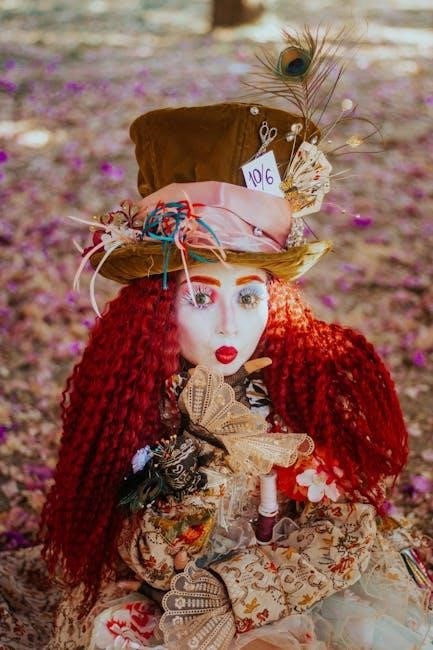
the flowers by alice walker pdf
The Flowers by Alice Walker: An Analysis
Alice Walker’s “The Flowers” is a poignant short story that explores the themes of innocence, loss, and the harsh realities of racial violence in the Deep South. The story follows a young girl named Myop as she confronts the brutal realities of her environment, marking a symbolic end to her childhood innocence.
Overview of the Story
Alice Walker’s “The Flowers” is a powerful and evocative short story set in the Deep South, exploring the themes of lost innocence and the grim realities of racial violence. The narrative centers around Myop, a ten-year-old African American girl, whose carefree exploration of the woods leads her to a disturbing discovery that shatters her innocent worldview. Walker masterfully uses symbolism and imagery to convey the story’s central message about the abrupt transition from childhood innocence to the harsh realities of adulthood in a racially charged environment.
Published in 1973, the story reflects the social and racial tensions prevalent in the American South during the Jim Crow era. Myop’s journey from joyful exploration to a stark realization of the violence and injustice that permeate her world is both heartbreaking and profound. The contrast between the beauty of nature and the ugliness of human cruelty is a central element, highlighting the devastating impact of racism on the lives of individuals and communities. “The Flowers” serves as a coming-of-age narrative, marking Myop’s loss of innocence and her awakening to the darker aspects of the world around her.
“The Flowers” by Alice Walker tells the story of Myop, a ten-year-old African American girl, who lives with her family in the rural South. One bright summer morning, Myop ventures into the woods near her home, exploring the natural world with a sense of carefree joy. She carries a stick, tapping it rhythmically as she walks, observing the beauty of the flowers, the pigs rooting by the spring, and the bubbles on the water’s surface. Lost in her innocent exploration, she strays from the familiar path and discovers a strange and beautiful flower, drawing her deeper into the woods.
As Myop continues her adventure, she stumbles upon the decaying corpse of a lynched man. The remnants of a noose hang above the body, and the air is thick with the stench of death. The vibrant blue flowers she had been collecting lie scattered nearby, juxtaposing the beauty of nature with the horror of human cruelty. This discovery marks a profound turning point for Myop, as her innocence is shattered by the stark reality of racial violence. The story concludes with Myop laying down her flowers, symbolizing the end of her childhood and her entrance into a world marred by racism and brutality.
Myop: A Character Analysis

Myop, the protagonist of Alice Walker’s “The Flowers,” is a complex character whose journey embodies the loss of innocence in the face of harsh reality. At the beginning of the story, Myop is portrayed as a carefree and innocent ten-year-old girl. She explores the natural world with a sense of wonder, delighting in the beauty of the flowers and the sounds of the forest. Her youthful exuberance is evident in her rhythmic tapping with a stick and her joyful observation of the world around her.
However, Myop’s encounter with the corpse of a lynched man dramatically alters her perception of the world. The discovery shatters her innocence, forcing her to confront the brutal reality of racial violence in the Deep South. This transformative experience marks a turning point in Myop’s life, as she moves from a state of blissful ignorance to a painful awareness of the dangers and injustices that surround her. The act of laying down her flowers at the end of the story symbolizes her loss of innocence and her entrance into a more complex and troubling world. Myop’s character serves as a powerful representation of the impact of racism on the lives of young African Americans during the Jim Crow era.
Symbolism of Flowers
In Alice Walker’s “The Flowers,” the flowers themselves serve as a powerful symbol, initially representing innocence, beauty, and the joys of youth. At the story’s outset, Myop is depicted collecting vibrant blue flowers, which signify her connection to the natural world and her untainted perspective on life. These flowers evoke a sense of vitality and happiness, mirroring Myop’s own carefree spirit as she explores the woods surrounding her home.
However, the symbolic meaning of the flowers undergoes a significant transformation when Myop discovers the remains of a lynched man. The vibrant flowers she has gathered stand in stark contrast to the horrifying reality of racial violence and injustice. As Myop lays down her armful of flowers near the corpse, it symbolizes the loss of her innocence and the end of her childhood naiveté. The flowers, once a symbol of beauty and joy, now represent the shattered dreams and the harsh realities of the world. This juxtaposition highlights the profound impact of racism on the lives of young African Americans during the Jim Crow era, forcing them to confront the ugliness of hatred and violence at a tender age.
The Loss of Innocence Theme

The central theme of Alice Walker’s “The Flowers” revolves around the loss of innocence, depicted through the experiences of Myop, a young African-American girl. Initially, Myop is portrayed as a carefree and innocent child, enjoying the simple pleasures of nature and unaware of the harsh realities of the world around her. Her exploration of the woods is filled with joy as she collects flowers and observes the beauty of her surroundings.
However, this innocence is shattered when she stumbles upon the decaying corpse of a lynched man. This shocking discovery forces Myop to confront the brutal reality of racial violence and injustice that permeates her society. The juxtaposition of her innocent activities with the horrifying sight of the dead man creates a stark contrast, highlighting the abrupt and devastating loss of her childhood naiveté. The act of laying down her flowers symbolizes the end of her innocence and the beginning of her awareness of the harsh realities of racism and brutality in the Jim Crow South. This transformative experience marks a significant turning point in Myop’s life, forever altering her perception of the world.
Racial Violence and its Impact
Racial violence is a central and disturbing theme in Alice Walker’s “The Flowers,” deeply impacting the narrative and the protagonist, Myop. The story subtly, yet powerfully, addresses the pervasive racism of the Jim Crow South through the discovery of a lynched man’s remains. This encounter exposes Myop, a young and innocent girl, to the brutal reality of racial hatred and violence that haunts her community. The image of the corpse, a stark symbol of injustice, shatters her idyllic worldview and forces her to confront the harsh realities faced by African Americans in the South.
The impact of this discovery is profound. Myop’s loss of innocence is directly linked to her realization of the racial violence that exists in her world. The flowers she had been joyfully collecting, symbols of beauty and life, are now juxtaposed with the ugliness and death caused by racial hatred. This contrast serves to underscore the devastating effect of racism on the individual and the community. Walker uses this single, powerful incident to highlight the broader social and historical context of racial violence in the American South and its lasting psychological impact on those who experience or witness it.
Setting in the Deep South
The setting of Alice Walker’s “The Flowers” in the Deep South is crucial to understanding the story’s themes and the protagonist’s journey. The narrative is steeped in the atmosphere of a rural, post-Civil War South, where the legacy of slavery and racial discrimination continues to shape the lives of its inhabitants. The natural landscape, initially presented as idyllic and serene, contrasts sharply with the underlying tension and potential for violence that permeates the region.
Walker’s descriptions of the lush fields, forests, and the family’s sharecropper cabin evoke a sense of both beauty and hardship. This juxtaposition reflects the duality of life for African Americans in the Deep South during this period. The setting is not merely a backdrop but an active participant in the story, influencing Myop’s experiences and shaping her understanding of the world. The woods, initially a place of innocent exploration, become a site of revelation and trauma, forever altering Myop’s perception of her surroundings. The Deep South setting, therefore, serves as a powerful symbol of the complexities and contradictions of American history and the enduring impact of racism on the landscape and its people.

Imagery and Diction in the Story
Alice Walker masterfully employs imagery and diction in “The Flowers” to create a vivid and contrasting portrayal of Myop’s experience. Initially, the language is light and airy, reflecting Myop’s innocent perspective as she explores the natural world. Descriptions of “sunny” mornings, “sweet” smells, and vibrant colors evoke a sense of youthful joy and freedom. Walker uses sensory details to immerse the reader in Myop’s world, emphasizing the beauty and tranquility of her surroundings.
However, as the story progresses, the imagery and diction shift dramatically. The discovery of the corpse brings a stark contrast, with descriptions becoming darker and more unsettling; Words like “rotted,” “broken,” and “grotesque” replace the earlier idyllic language, reflecting Myop’s loss of innocence. The once-beautiful flowers, now juxtaposed with the horrifying reality of racial violence, symbolize the corruption of innocence and the harsh realities of the Deep South. Walker’s careful use of language and imagery underscores the story’s central theme: the abrupt and devastating impact of encountering the ugliness of the world on a child’s naive understanding.

The Significance of the Ending
The ending of Alice Walker’s “The Flowers” is profoundly significant, leaving a lasting impact on the reader. After Myop discovers the decaying corpse of a lynched man, she lays down the armful of flowers she had been collecting. This simple act is laden with symbolism, representing the definitive end of her childhood innocence and the abrupt confrontation with the harsh realities of racial violence in the Deep South.
The discarded flowers symbolize the loss of her naive worldview, the beauty and joy of her youthful existence now tainted by the ugliness of hatred and brutality. Myop’s innocent exploration of nature is forever altered, as she can no longer ignore the darkness that lurks beneath the surface of her seemingly peaceful world. The ending serves as a powerful commentary on the devastating impact of racism and violence on the lives of young people, forcing them to confront the complexities and injustices of society at a tender age. It is a poignant moment of awakening, marking the transition from childhood innocence to a more mature, albeit disillusioned, understanding of the world.
Alice Walker’s Style and Narrative Technique
Alice Walker’s distinct style and narrative technique in “The Flowers” are crucial to the story’s impact. Walker employs a third-person perspective, initially presenting Myop’s innocent world through vivid sensory details. The language is rich with imagery, depicting the beauty of the natural setting and Myop’s carefree spirit. This idyllic portrayal is sharply contrasted by the stark, brutal discovery that shatters her innocence.
Walker masterfully uses symbolism, with the flowers representing Myop’s youth and the lynched man symbolizing the pervasive racial violence of the Deep South. The shift in tone from lighthearted to somber reflects Myop’s changing perception. The narrative is concise yet powerful, conveying deep emotions and complex themes with remarkable efficiency. Walker’s attention to detail, particularly in describing the natural environment, serves to highlight the contrast between beauty and brutality, innocence and experience. This masterful blend of style and technique makes “The Flowers” a compelling and unforgettable exploration of loss and awakening.
Historical Context: Jim Crow South
“The Flowers” is deeply rooted in the historical context of the Jim Crow South, a period characterized by systemic racial segregation and violence against African Americans. These laws and social customs enforced inequality in all aspects of life, from education and employment to housing and legal rights. The story reflects the ever-present threat of racial violence, particularly lynching, which was used to terrorize and control Black communities.
Myop’s encounter with the lynched man is a stark reminder of this brutal reality. The innocence of her childhood is abruptly shattered by the discovery of this act of violence, symbolizing the loss of innocence experienced by many African American children growing up in this oppressive environment. Walker’s story serves as a powerful indictment of the Jim Crow South, highlighting the devastating impact of racism on individuals and communities. Understanding this historical context is essential to fully appreciate the story’s themes of loss, awakening, and the enduring legacy of racial injustice. The setting is not merely a backdrop but a crucial element shaping Myop’s experience and the story’s message.
Comparison to Walker’s Other Works
Alice Walker’s “The Flowers” shares thematic and stylistic similarities with her other works, particularly those exploring the experiences of Black women in the face of adversity. Like “The Color Purple,” “The Flowers” delves into the impact of racism and violence on the emotional and psychological development of its protagonist. Walker’s exploration of innocence lost and the awakening to harsh realities is a recurring motif in her writing.

In “Revolutionary Petunias,” Walker uses flowers as a symbol of Black women’s resilience and resistance, contrasting with the flowers in “The Flowers” that represent the loss of innocence. Her collection “In Love and Trouble: Stories of Black Women” also explores the complex lives of Black women navigating social and political challenges. Walker’s signature narrative technique, characterized by vivid imagery and a focus on the internal lives of her characters, is evident in both “The Flowers” and her other works.
By examining “The Flowers” in the context of Walker’s broader body of work, we gain a deeper understanding of her commitment to portraying the experiences of Black women and challenging the social injustices they face.
“Revolutionary Petunias” and Flower Symbolism
Alice Walker’s short story, “Revolutionary Petunias,” offers a compelling contrast to the flower symbolism found in “The Flowers.” While “The Flowers” utilizes flowers to represent the loss of innocence and the harsh realities of racial violence, “Revolutionary Petunias” employs them as symbols of Black women’s rebellious strength and resilience in the face of oppression. The petunias in this story embody a vibrant, defiant spirit, showcasing the ability to find beauty and strength even in difficult circumstances.
In “The Flowers,” the initial joy Myop experiences with the flowers sharply contrasts with the grim discovery she makes, highlighting the abrupt end of her innocence. This contrasts sharply with the symbolism in “Revolutionary Petunias” where the flowers represent enduring strength. Walker’s deliberate use of flower symbolism in both stories underscores her nuanced exploration of Black women’s experiences, showcasing both their vulnerability and their unwavering spirit.
The duality in flower symbolism across Walker’s works emphasizes the complexity of human experiences and the varied ways in which individuals confront adversity.

The Story as a Coming-of-Age Narrative
“The Flowers” functions effectively as a coming-of-age narrative, charting the protagonist Myop’s journey from childhood innocence to a stark awareness of the brutal realities surrounding her. At the story’s outset, Myop is portrayed as a carefree and joyful child, happily exploring the natural world and disconnected from the harsh realities of the Jim Crow South.
The pivotal moment of discovery, when Myop stumbles upon the decaying corpse of a lynched man, shatters her idyllic worldview. This encounter forces her to confront the pervasive racism and violence that permeate her society, abruptly ending her childhood innocence. The act of laying down the flowers symbolizes Myop’s symbolic shedding of naiveté, marking her entrance into a more complex and somber understanding of the world.
Through Myop’s transformative experience, Walker highlights the profound impact of racial injustice on the development of young Black individuals. The narrative serves as a powerful commentary on the loss of innocence and the premature exposure to harsh realities that many children face in environments marked by systemic oppression.
Themes of Racism and Brutality
Racism and brutality are central themes in Alice Walker’s “The Flowers,” deeply embedded within the narrative’s core. The story subtly unveils the pervasive and insidious nature of racial violence in the Jim Crow South, a historical period marked by systemic oppression and injustice against African Americans. While the explicit depiction of violence is minimal, its presence looms large, casting a dark shadow over Myop’s innocent world.

The discovery of the lynched man’s corpse serves as a stark reminder of the ever-present threat of racial violence that African Americans faced during this era. The man’s death symbolizes the countless acts of brutality and injustice that went unpunished, perpetuating a culture of fear and intimidation within the Black community.
Walker masterfully uses symbolism and imagery to convey the devastating impact of racism on the lives of individuals and communities. The once vibrant and carefree world of Myop is forever tainted by the grim reality of racial violence, forcing her to confront the harsh truths of her environment and the vulnerability of those around her.
The Significance of the Corpse
The corpse in Alice Walker’s “The Flowers” is not merely a dead body; it is a potent symbol representing the brutal realities of racism and violence prevalent in the Deep South. Its presence marks a turning point in the narrative, shattering Myop’s innocence and forcing her to confront the harsh truths of her environment.
The decaying body, a victim of lynching, serves as a stark reminder of the dehumanization and injustice inflicted upon African Americans during the Jim Crow era. It represents the countless lives lost to racial hatred and the systemic oppression that perpetuated a culture of fear and violence.
The discovery of the corpse disrupts Myop’s idyllic world, forever altering her perception of reality. The once vibrant and carefree landscape is now tainted by the grim reminder of human cruelty and the fragility of life. The corpse becomes a symbol of lost innocence, marking the end of Myop’s childhood and her awakening to the harsh realities of the world around her. It forces her to confront the dark underbelly of her community and the ever-present threat of racial violence that looms over her existence.
The Message of the Story
Alice Walker’s “The Flowers” delivers a powerful message about the loss of innocence and the harsh realities of racial injustice. The story serves as a stark reminder of the violence and oppression experienced by African Americans in the Jim Crow South, and the impact it had on their lives, especially the young.

Through Myop’s journey, Walker highlights the vulnerability of childhood innocence in the face of such brutality. The story conveys a sense of disillusionment as Myop’s carefree world is shattered by the discovery of the lynched man’s body.

The flowers themselves, initially symbols of beauty and joy, become ironic reminders of the ugliness and violence that exist beneath the surface. The story suggests that true understanding requires acknowledging the uncomfortable truths of the past and confronting the ongoing effects of racism. It serves as a call to awareness, urging readers to recognize the importance of empathy, justice, and the preservation of innocence in a world marred by prejudice and hate. The message lingers long after the final sentence, prompting reflection on the human cost of intolerance.
Leave a Reply
You must be logged in to post a comment.